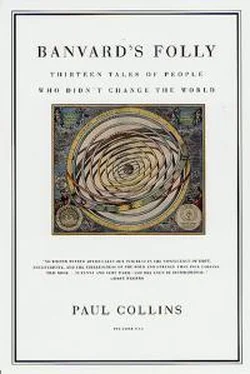The initial suggestion that Johnson's petition first go to the Committee of Foreign Relations was sensible, as the voyage would surely result in establishment of trade relations with inhabitants of the Interior World. But despite having a number of supporters in the Senate, the entire petition was indefinitely tabled by the end of the day's debate.
Still more petitions and letters came in. The next January it came to a vote again, this time in the House of Representatives, but was again tabled.
Supporters lobbied hard, and in the following month seven more bills appeared in the House--five from Ohio, one from Pennsylvania, and one from South Carolina. All were tabled or struck down in rapid succession.
Amid these political maneuverings, ridicule and disbelief dogged Symmes in many quarters. The August 27, 1822, issue of the Charleston, West Virginia, Courier was fairly typical in this regard. In an article titled "The Year 2150
Anticipated," an anonymous satirist imagines a world in which Symmes is lauded to a ludicrous extent as the greatest genius who ever lived, thanks in large part to the usefulness of the Inner World as a depository for criminals, the insane, and the criminally insane.
Symmes pushed onward. After another fruitless attempt in both houses of Congress in late 1823, he moved to a newly inherited family farm in Hamilton)!), Ohio, and took his case directly to his new home state, petitioning the Ohio general assembly to pass a bill supporting his theory. It failed. Discouraged and nearly broke, Symmes's health began to falter, and he
spent much of 1824 and 1825 ill. But his earnest guilelessness had impressed some people so much that whether or not they believed his theory, they would write to him or press just enough money into his palm to sustain him. When a benefit was held for him on March 24, 1824, at the Cincinnati Theatre, Symmes was even treated to a bit of well-meaning doggerel penned for the occasion by local poet Moses Brooks:
Has not Columbia one aspiring son, By whom the unfading Laurel may be won?
Yes! history's pen may yet inscribe the name Of SYMMES to grace her future scroll of
fame.
Symmes had also attracted a disciple who was to prove both his greatest boon and bane in the remaining years of his life. Jeremiah Reynolds was an ambitious young editor of the Wilmington Spectator, and a great admirer of Symmes's theories, when he approached the great man himself with a plan. What good was it, he argued, if Symmes only addressed paltry crowds of frontier bumpkins? The places to go were the great urban and manufacturing centers of the Northeast--rather than nibbling at the margins, Symmes should go straight for the financial and intellectual heart of the republic.
Symmes blanched at the thought of this. Facing crowds of simple homesteaders was nerve-racking enough for him; the idea of lecturing before audiences of cosmopolitan intellectuals was simply terrifying. But Reynolds was persistent--they would both go! This reassured Symmes somewhat, for Reynolds had the polished magnetism and youthful energy that Symmes lacked. With great hesitation, Symmes set off for the East with his twenty-six-year-old disciple in September 1825.
Their timing was fortuitous, for another Symmes admirer--one who perhaps had his best interests a little closer to heart--had during Symmes's 1824 illness set about compiling a book that would explain Symmes's theory with much greater aplomb and clarity than Symmes himself had ever managed. Released just months after the tour began, James McBride's Symmes's Theory of Concentric Spheres anticipated the arguments and examples of nearly every subsequent work on the subject. And while McBride does not shy from some of the more arcane aspects of Symmes theories, such as the "elastic fluid" aerating the inner earth that acts as a sort of antigravity force, it was his homely examples that struck a chord with many readers. Any reader could ascertain the truth of Symmes's theory within a matter of minutes:
If you will take the trouble to examine a mechanic grinding cutlery on a large stone that is smooth on the sides and has a quick motion, you may observe that if a certain portion of water be poured on the perpendicular side whilst the stone is turning, it does not settle or form itself into a body round the crank or axis, but forms itself on the side of the stone into something resembling concentric circles, one within another. The surface of the earth, I apprehend, revolves with much greater velocity than any grindstone; and the substances composing the spheres are much firmer than water.
For the keen observer--or the keen believer, at least--concentric circles were everywhere in nature, whether in the ripples propagating upon a pond or in the mysterious alignments of iron filings around a lodestone.
It was just such devices that Symmes and Reynolds unveiled to audiences in their traveling show, playing to packed houses at fifty cents a head. With magnets, boxes of sand, whirling stones, and Symmes's well-worn wooden globe, audiences members were brought face to face with the laws of the universe ...
laws that inexorably led to a hollow earth. Skeptics who arrived at a Chambersburg, Pennsylvania, lecture in January 1826, one local editor observed, sat dumbstruck by the force of the pair's argument--"a breathless silence prevailed"--and erupted in applause at the end of the lecture. Even the editor, who had before written Symmes off as a loon, conceded the next day in his paper:
Facts, the existence of which will not admit of a doubt, and the conclusions drawn from them are so natural ... that they almost irresistibly enforce conviction on the mind .... The cost of an experiment [expedition] would be trifling, and discoveries of importance would most probably be made, tho'
Symmes should be found erroneous.
This last sentiment proved to be Symmes's undoing. The pair moved on to Harrisburg, where they addressed the Pennsylvania legislature, which responded with an enthusiastic letter of support for the man who had managed to stand up
"in awe of the world's dread laugh." Still, Symmes's fragile health was brought to the breaking point by the touring, and after the two finally reached the apex of their tour, Philadelphia, Reynolds had to take on most of the lecturing. Reynolds had noticed the audience's enthusiasm for a polar expedition, regardless of the veracity of the hollow earth theory, and started simply omitting Symmes's theory from most of his lectures. The two soon parted.
Symmes staggered on through the winter of 1826-27, lecturing with his props and his grand notions throughout New York and New England and all the way up into Canada, but the strain of stage fright exacerbating his already poor health was simply too much, and he called off the rest of his tour. For the next two years he stayed with an old friend in New Jersey, hoping merely to gain enough strength to go back home to his Ohio farm. When he finally did make the long journey back home, his son later recalled, "he was so feeble that he had to be conveyed on a bed, placed in a spring wagon, to his home near Hamilton."
From his sickbed he continued to churn out circulars on his proposed expedition, but with bitter knowledge that Reynolds, who had once promised so much, was now in Washington lobbying Congress to explore the south pole ...
for whaling and sealing.
In May 1829, Symmes died, believing right up to the end that the greatest discovery in the human history had eluded his grasp.
And yet the dream did not die with the dreamer. Although Reynolds succeeded in getting President Adams's approval for an expedition, successor Andrew Jackson canceled the project, and it was not revived for nearly a decade. But in the meantime, Reynolds found a sympathetic ear in a wealthy New York patron named Dr. Watson. Watson and Reynolds outfitted an expedition for the south pole and set off in the SS Annawan from New York Harbor in October 1829. Upon reaching sight of the shores of Antarctica, they found their way through the
Читать дальше











